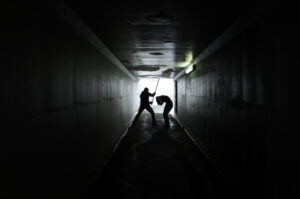An earthquake of magnitude 8 occurred offshore from Gloucester and damaged coastal areas; it was the largest earthquake experienced in Massachusetts up to that time.
On November 18, 1755, a magnitude 8 earthquake, centered offshore two hundred miles east of Gloucester, severely damaged areas onshore. Heaviest damage occurred around Gloucester. It was the largest earthquake experienced in Massachusetts up to that time. Shaking was strongest all along the coastal areas southwards toward and around Boston. Within the city of Boston there was considerable damage. As many as 1,600 chimneys were knocked down and the brick walls and roofs of several buildings collapsed. Stone fences were thrown down throughout the countryside, particularly on a line extending from Boston to Montreal, reminiscent of an earlier earthquake around Montreal in the previous century which destroyed several stone chimneys in Boston.
Earth movements took place west and south of Boston; new springs formed, and old springs dried up. Cracks opened in the earth and water and fine sand issued from some of the ground cracks. The impact of the earthquake was felt in Halifax and Montreal in Canada, in Chesapeake Bay in Maryland, and on a ship that was at the epicenter. There, above the epicenter, the shock was felt so strongly that those on-board believed the ship had run aground. There were several aftershocks. An area of reclaimed land near the wharfs in Boston was damaged to a greater extent than anywhere else. It may have been one of the first examples of liquefaction, that is to say a ground surface changing to a mixture of water and mud during an earthquake, a problem that appeared later where buildings had been erected on unconsolidated sediments.
This earthquake may also be the first record of a tsunami in the U.S., now a familiar story in subsequent records of major earthquakes, especially the powerful 1964 earthquake in Alaska. In other countries, as we know from the devastating tsunami of 2004 in Sumatra, Indonesia, tsunamis have often been experienced. The Lisbon earthquake of the same year as the one in Massachusetts was one of the most powerful tsunamis ever known up to that time. This 1755 earthquake off Gloucester affected other vessels near the epicenter and left a few vessels aground in the Leeeward Islands, more than a thousand miles away to the south. In that area the typical tsunami effect of water being drawn back from the harbor was observed—fish were left on the banks along with anchored vessels and then, a short time afterward, a larger wave that was six feet higher than normal swept ashore.
The Gloucester earthquake, often referred to by the name “Cape Ann,” was interpreted in the popular mind as a judgment from God for bad behavior. There were similar interpretations in other locations, at different times, including the United States today, despite our present understanding of the causes of earthquakes. In the case of the Gloucester quake there were additional reasons for attributing causation to the direct action of God. Widespread religious revivals had been taking place throughout New England under the leadership of Jonathan Edwards and they carried warnings of the imminent judgment of God against all who did not repent. Historians have identified a consistent theme in all the published sermons of that time, namely that the ground had shaken because of the moral imbalance in human behavior. In some southern states the influence of earthquakes on religious behavior was dramatically expressed in the increase of people attending Methodist churches. From 1811 to 1812, the dates of the Madrid quakes, their numbers jumped by 50 percent. For the prior decade this denomination’s numbers had changed very little.






















